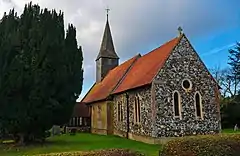| Hoath | |
|---|---|
 Holy Cross Church, Hoath | |
 Hoath Location within Kent | |
| Area | 6.51 km2 (2.51 sq mi) |
| Population | 551 (Civil Parish 2011)[1] |
| • Density | 85/km2 (220/sq mi) |
| OS grid reference | TR200641 |
| District | |
| Shire county | |
| Region | |
| Country | England |
| Sovereign state | United Kingdom |
| Post town | CANTERBURY |
| Postcode district | CT3 |
| Dialling code | 01227 |
| Police | Kent |
| Fire | Kent |
| Ambulance | South East Coast |
| UK Parliament | |
Hoath is a semi-rural village and civil parish in the City of Canterbury local government district. The hamlets of Knaves Ash, Maypole, Ford, Old Tree, Shelvingford and Stoney Acre are included in the parish.
Etymology
In Kent and East Sussex the Old English term hǣð, which became heath in Modern English, was replaced by an unmutated form, hāð, which, over time, evolved into Hoath. The name thus means "heath".[2]
History
Hoath was part of the estate granted by King Ecgberht of Kent in 669 for the foundation of the church at Reculver,[3][4] and remained part of that estate when King Eadred granted it to Archbishop Oda of Canterbury in 949.[5][Fn 1] A chantry either in or connected with Hoath is recorded in the 14th century, with John Gardener as the chaplain, successor to Henry atte Were.[7] On 9 December 1410 Archbishop Thomas Arundel dedicated a chapel to the Virgin Mary and consecrated a burial-ground at Hoath at the request of the inhabitants and his tenants there who, led by Sir Nicholas Haute, Peter Halle Esq. and Richard Hauk, then chaplain of the chantry, promised to observe his ordinances.[8]
The hamlet of Ford was the location of Ford Palace, a residence of the Archbishops of Canterbury from at least the 14th century to the 17th.[9] Robert Hunt, chaplain to the expedition that founded the first successful English colony in the New World, at Jamestown, Virginia in 1607, was born in Hoath in the late 1560s or early 1570s.[10][11]
Amenities
Within Hoath there is a small primary school, a camp site called Southview Camping, a public house named the Prince of Wales, and a village hall.
A late medieval church, Holy Cross, stands on Church Road, and was originally a chapel-of-ease for St Mary's Church, Reculver. The building was renovated by Joseph Clarke between 1866 and 1867, when a north aisle was added.[12]
Hoath has a small general aviation airfield (ICAO: EGHB) west of the village near Maypole.
References
Footnotes
Notes
- ↑ Key Statistics; Quick Statistics: Population Density United Kingdom Census 2011 Office for National Statistics Retrieved 21 November 2013
- ↑ P. H. Reaney (1969). The Origin of English Place Names. Routledge and Kegan Paul. p. 45. ISBN 0-7100-2010-4.
- ↑ Gough 2001, p. 251.
- ↑ Garmonsway 1972, pp. 34–5.
- ↑ Gough 1992.
- ↑ Flight 2010, p. 162.
- ↑ Plea Rolls of the Court of Common Pleas; National Archive; CP 40/541, year 1396 (first entry, with "Kant" in the margin); the dispute concerned whether a situation should be investigated in the secular or ecclesiastical Courts.
- ↑ The National Archives (UK) Discovery Catalogue, ref. CCA-DCc-ChAnt/R/21 (Canterbury Cathedral Archives).
- ↑ Gough 2001.
- ↑ "The Reverend Robert Hunt: The First Chaplain at Jamestown". nps.gov. Retrieved 28 July 2015.
- ↑ Gough 1984, p. 21.
- ↑ "Holy Cross Church, Hoath - Architectural & Historical Information". Retrieved 6 August 2015.
Bibliography
- Flight, C. (2010), The Survey of Kent: Documents Relating to the Survey of the County Conducted in 1086, BAR British Series, vol. 506, Archaeopress, ISBN 978-1-4073-0541-7, archived from the original on 17 December 2012, retrieved 23 May 2014
- Garmonsway, G.N., ed. (1972), The Anglo-Saxon Chronicle, Dent, ISBN 0-460-11624-X
- Gough, H. (1984), "The cure of souls at Hoath", in McIntosh, K.H.; Gough, H.E. (eds.), Hoath and Herne: The Last of the Forest, K. H. McIntosh, pp. 19–23, ISBN 978-0-95024-237-8
- Gough, H. (1992), "Eadred's charter of AD 949 and the extent of the monastic estate at Reculver, Kent", in Ramsay, N.; Sparks, M.; Tatton-Brown, T. (eds.), St Dunstan: His Life, Times and Cult, Boydell, pp. 89–102, ISBN 978-0-85115-301-8
- Gough, H. (2001), "The Archbishop's manor at Ford, Hoath" (PDF), Archaeologia Cantiana, 121: 251–68, ISSN 0066-5894, archived (PDF) from the original on 13 September 2015
External links
- www.hoath.org - village website with news, upcoming events and a history of the village
